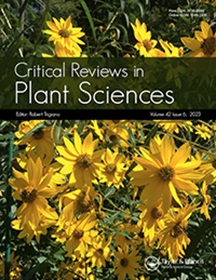microrna介导的植物次生代谢基因调控
IF 4.9
2区 生物学
Q1 PLANT SCIENCES
引用次数: 5
摘要
植物microRNAs (miRNAs)是一类长约21个核苷酸的小非编码rna (ncRNAs),通常通过引导mRNA的切割或翻译抑制而成为其靶基因的关键调控因子。近年来有研究报道,miRNAs可与通路相关结构基因、转录因子(tf)和非编码rna (ncRNAs)相互作用,在次生代谢物(SM)生物合成通路中形成调控网络。经过验证的相互作用可以更好地反映miRNA的真实调控机制,并将miRNA转化为更有效的工具来控制宝贵的SMs的产生。然而,目前还没有关于这一主题的系统综述,特别是在植物,特别是模式植物和作物方面。本文首先综述了植物次生代谢的关键途径,特别是与结构基因相关的生物合成途径,包括苯丙素、萜类、生物碱等。本文主要综述了近十年来参与SMs生物合成的mirna、mirna靶模块及其对上述途径的调控。值得注意的是,这些模块包括mirna -结构基因、miRNA-TF、miRNA-ncRNA相互作用对,通过靶标验证或功能确认进行。这些知识将促进对复杂的mirna介导的SM生物合成基因调控网络的理解,并推动合成生物学的发展。本文章由计算机程序翻译,如有差异,请以英文原文为准。
MicroRNA-Mediated Gene Regulation of Secondary Metabolism in Plants
Abstract Plant microRNAs (miRNAs), a class of about 21-nucleotide-long small noncoding RNAs (ncRNAs), generally act as key regulators of their target genes by guiding mRNA cleavage or translational repression. Recent researches have reported that miRNAs can interact with pathway-related structural genes, transcription factors (TFs) and noncoding RNAs (ncRNAs) to form regulatory network in secondary metabolite (SM) biosynthetic pathways. The validated interactions can better reflect the real regulatory mechanism of miRNA and convert miRNAs into more efficient tools to control the production of precious SMs. However, there is no systematic review available on this topic especially in plants, particularly model plants and crops. Here, we firstly overviewed the critical secondary metabolic pathways in plants, especially those biosynthetic pathways related structural genes which were well-studied and representative SMs, including phenylpropanoids, terpenoids, alkaloids. Principally, we summarized miRNAs involved in the biosynthesis of SMs, miRNA-target modules and their regulation on the mentioned pathways in the last decade. Significantly, the modules included miRNA-structural gene, miRNA-TF, miRNA-ncRNA interaction pairs carried out by target validation or functional confirmation. This knowledge will promote understanding the sophisticated miRNA-mediated gene regulatory network of SM biosynthesis, and drive the development of synthetic biology.
求助全文
通过发布文献求助,成功后即可免费获取论文全文。
去求助
来源期刊
CiteScore
12.90
自引率
1.40%
发文量
15
审稿时长
>12 weeks
期刊介绍:
Critical Reviews in Plant Sciences focuses on presenting in-depth and up-to-date reviews of timely and/or cutting-edge subjects in the broad discipline of plant science, ranging from molecular biology/biochemistry through the areas of cell biology, plant pathology and physiology, genetics, classical botany, and ecology, to practical agricultural applications. Articles in the journal provide an up-to-date literature base for researchers and students, pointing the way towards future research needs. The journal is also a significant source of credible, objective information to aid decision makers at all levels.

 求助内容:
求助内容: 应助结果提醒方式:
应助结果提醒方式:


